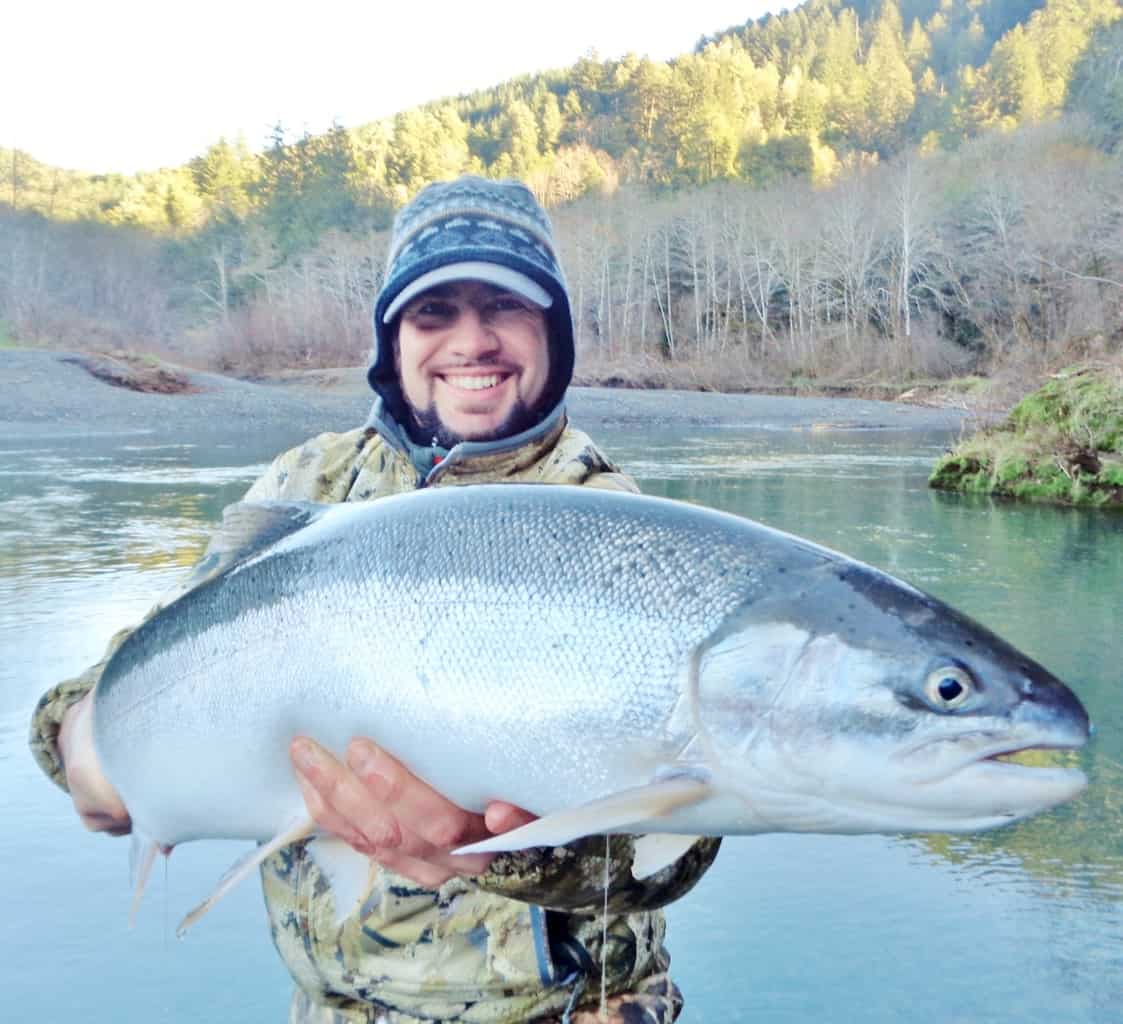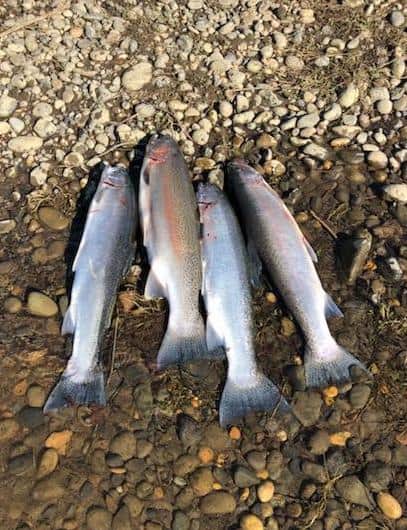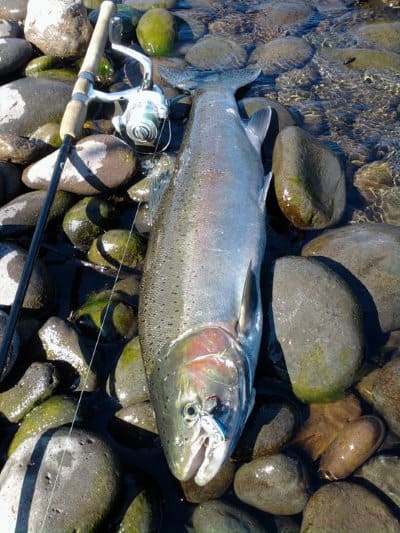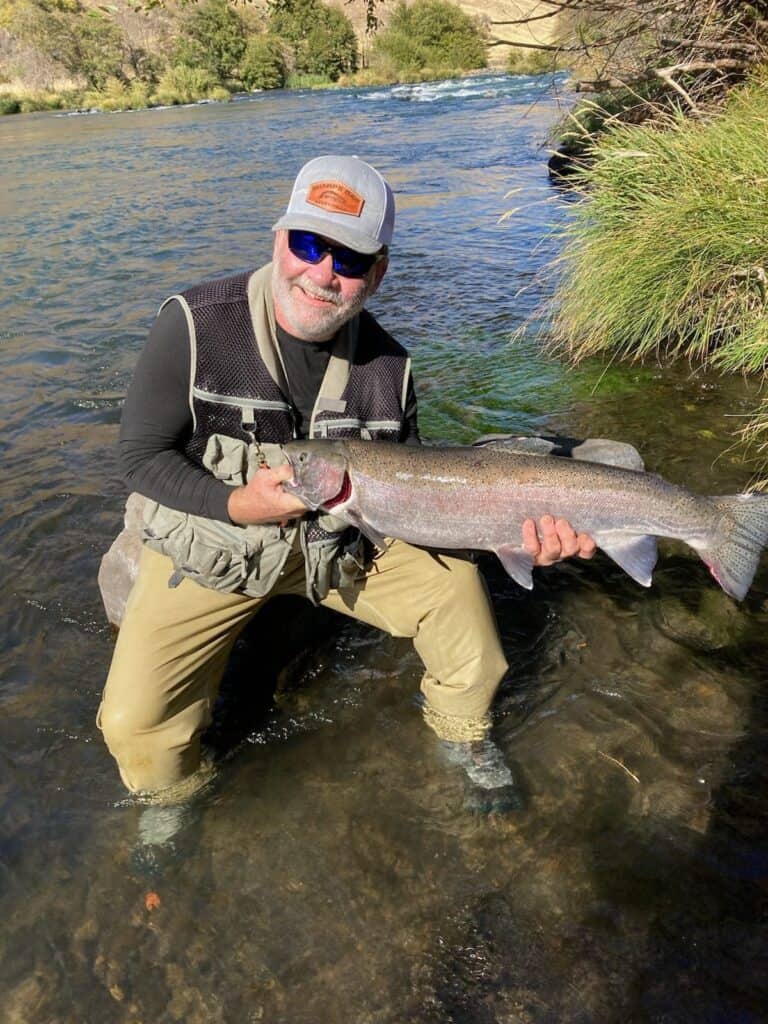Steelhead are at the top of sought-after game fish in western North America.
As ocean-going rainbow trout, steelhead are anadromous, meaning they migrate from the rivers and creeks they hatch in and move into the ocean or large water, then returning as much larger fish to the rivers where they hatched to spawn.
The Great Lakes have transplanted steelhead that run up the rivers in the area, whereas the Pacific Northwest (PNW) and other parts of the West are home to native, ocean-run steelhead.
(If you’d like to pinpoint rivers near you that offer the best steelhead fishing, stick around until later in this article and we’ll link you to articles that will point your car in the right direction.)
Steelhead tend to stay in the rivers they are hatched in for a time before starting their migration, sometimes nearing the size of typical trout before leaving their birth streams.
A defining characteristic of steelhead is their size compared to typical rainbow trout. Steelhead eat well in the ocean, which helps them outpace their river cousins in size.
When they migrate to the ocean, they lose their bright rainbow coloring and become more silvery, similar to salmon in the ocean.
Once they have been back in the freshwater rivers for a little while, they start regaining their brighter patterns.
If you target a species based on its ability to fight, steelhead should be high on your list. These muscular trout are acrobatic, strong and full of energy. They can definitely wear you out after a productive day’s fishing.
In some areas including the Pacific Northwest, there are two primarily steelhead runs each year.
Some steelhead make their return to the rivers in the summer, while others migrate home during the winter. We will focus on the differences in runs later.
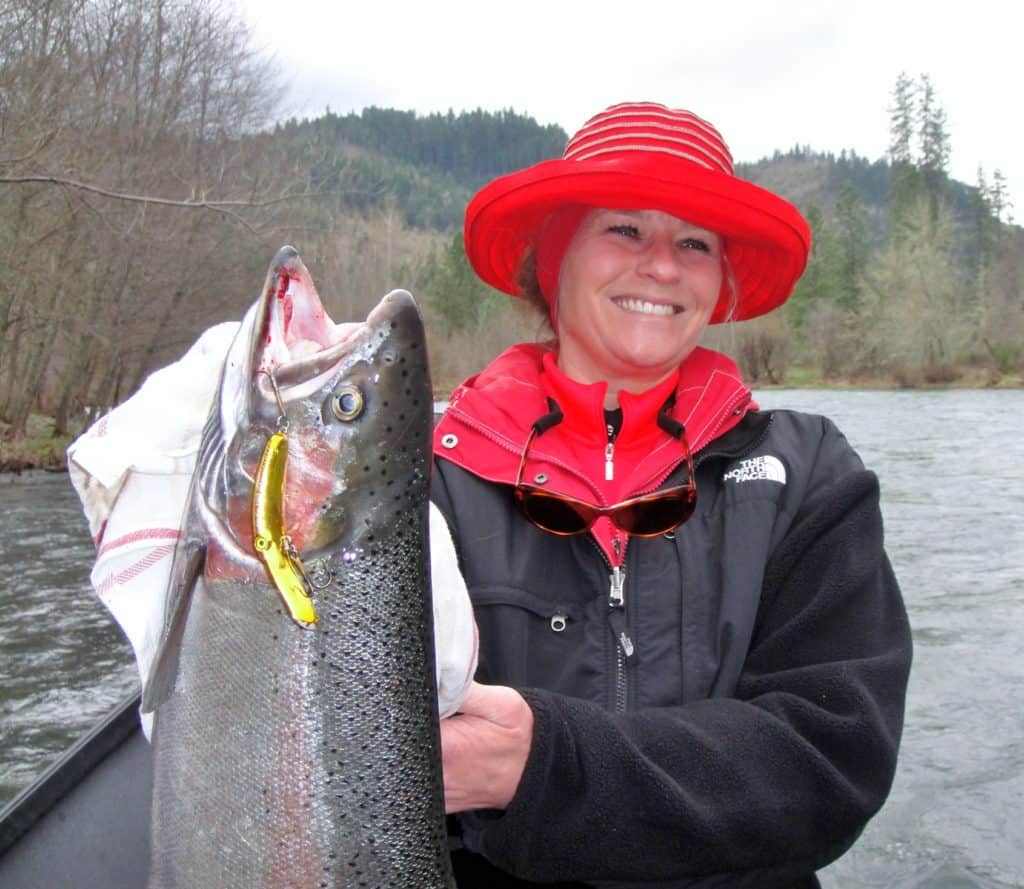
Where Can I Catch Steelhead?
Steelhead are native to the West Coast from California to Alaska, and in many areas, their numbers are supplemented by hatchery programs to increase harvest opportunities. Steelhead have also been introduced to the Great Lakes region and have flourished there.
Keep in mind that steelhead are notoriously difficult to catch. Some anglers call them the “Fish of 1,000 Casts.” Be prepared for days when you just can’t hook one.
When West Coast steelhead return to spawn, they can be found in many tributary rivers along the coast. Some also can travel quite far, with rivers as far inland as Idaho having excellent steelhead runs.
Targeting specific waters for steelhead takes planning, research and patience. Read as much as you can on specific river systems to understand the timing and techniques used in these waters.
Some rivers have both summer and winter runs of steelhead, while many rivers will have one or the other.
Both summer and winter runs typically spawn in the spring. However, the summer run enters rivers much earlier than winter runs, where they begin to act more like resident trout as reach spawning maturity.
Rivers holding steelhead are abundant, as are the anglers searching their banks. Some of the best spots can get extremely crowded.
When approaching groups of anglers fishing the same hole you’re interested in, make sure you use proper etiquette. Don’t cast over others, don’t wade out into the hole where others are fishing, and finally, don’t be a jerk.
Choosing the right water will make all the difference.
Steelhead prefer rocky or gravelly areas that are at least a few feet deep with a current. Boulders and rocky areas are going to hold more fish than areas without any cover. Steelhead holding in shallower water also like some riffles on the top of the stream to make them harder to spot.
If there are boulders and large rocks in the river, try bouncing your bait or lure off the rocks and into the pockets often found behind rocks. You might find one right there waiting.
Another good place to try is where the water slows right after a sizeable rapidly moving section of the river. They may hold in the calm water to rest and prepare for the run through the rapids ahead.
Take the time to research your chosen river before getting your feet wet. Spending too much time on a non-productive section or system can ruin an otherwise excellent fishing trip.
We already have articles pointing you to some of the best steelhead rivers on the West Coast and Great Lakes areas.
The steelhead of the Great Lakes region have their own runs that can see 50,000-75,000 stacked up in rivers.
The St. Joseph River in Michigan and Indiana is one of the highest-rated in the area, but don’t overlook the Niagara River in New York and Ontario, Canada for some pretty stellar numbers as well.
How to Read Steelhead Water
Steelhead can hold up in many different sections of the waterway. However, the where and why of finding fish in each section can be difficult to decode.
Rivers and creeks all have at least some similar characteristics. Riffles and rapids are universal.
You will find a beginning, or top riffle, a middle section, which slows down into a pool, and a tailwater. Every run has these three characteristics. They may not be present in even amounts, but they are there.
The top of a run will present with shallower water, a rock base, and a steeper angle than lower down.
The faster riffle and current can provide some secure areas for steelhead, especially if the water levels are lower. They can nose up into the upper pool areas to hide under current and behind rocks.
When the fish are actively running in the earlier part of the season, you also can, at times, focus on these areas to target them as they move through.
Always match the speed of the water in the section you are fishing. A tip I like when evaluating water is that steelhead often hold in water that is moving at about the speed I walk.
The middle sections, where water pools and gets deeper, at times can be the money spot, depending on the day. Deep sections are often best if the fish need to rest, or if the top and bottom of a pool are too shallow for steelhead to feel secure.
These deeper sections are going to provide a slower current, naturally formed cover, and perhaps larger groups of fish holding in the water together. If the pools are widening out, try testing the underwater ledges along the edges of the run.
In these sections, try to bounce off the bottom as lightly as possible to avoid snags. Remember, you want to focus on fishing, not re-rigging your rod every 10 minutes.
Fish the centerline, then edge out toward the bank a little each time you pass through. Cover as much of the water as possible.
Winter-run steelies very often tend to hold in the tailwaters of pools, often called tail-outs.
Tail-outs are generally right below the pools and above the next downstream rapids, usually between the shallowest and lowest part of the pool and the deeper sections up above.
Tail sections can be super productive for some techniques we’ll tell you about, but they lack accessibility for side drifting from a boat.
The water tends to get relatively shallow as it moves back into rapids. During low water, these may be inaccessible to boats, making the bank anglers happy.
Cast from as far a distance as possible in these sections. Fish can be easily spooked here. Cast towards or above structure or other spots you think hold fish, anticipating the steelies to be hanging out below boulders.
You may be able to sight fish for steelhead, especially in tail-outs and runs that are waist-deep or less.
Watch your lure or bait as you move it through the water. Sometimes, you’ll see a steelhead flash sideways to get a look. Even if that fish doesn’t strike, it might do so the next cast or with another type of lure or bait.
When Is the Best Steelhead Fishing?
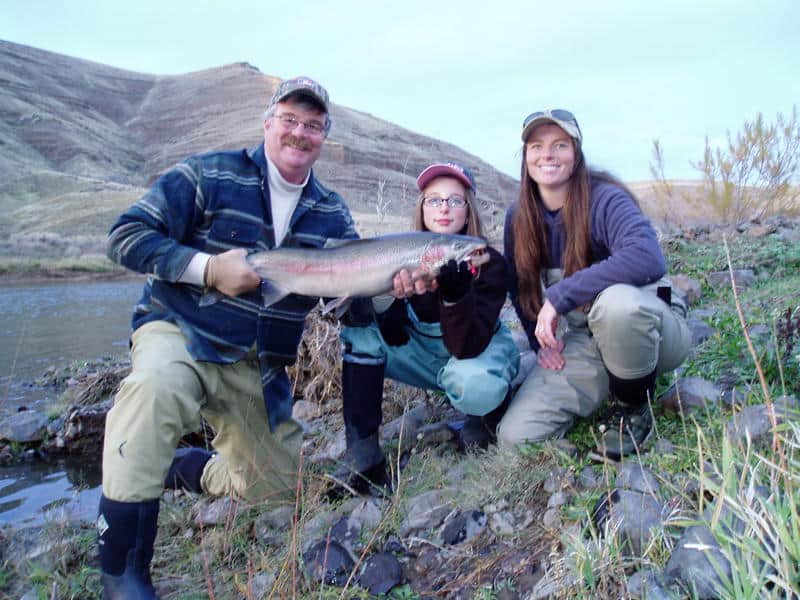
They say the best time for any fishing is when you can get out there to fish. That holds true most of the time, but steelhead are trickier when it comes to timing.
With the different runs happening throughout the year, it is possible to get onto a steelhead all year long in some parts of the country. That doesn’t mean it’s a particularly successful trip, but if you learn when the runs peak in each river you fish, you’ll boost your odds considerably.
The time of day, anglers already on the water, water conditions, and a laundry list of other factors can make or break the best-made plans.
Fly fishing anglers traditionally hold with the notion that the best time is throughout the day.
Bait and tackle anglers might express an opinion that evenings and very early mornings (often securing their fishing spots well before the sun is up) are best for bringing in the big ones.
Each opinion has its merits.
Let’s look more at the timing of each run, which is critical to your success. It makes sense: Fish when there are more fish.
Summer run steelhead start migrating as early as March and will peak in late spring to early summer in some coastal and shorter streams and rivers.
By contrast, summer steelhead may begin their journeys early in the season but not actually arrive at their home rivers until much later.
For example, runs that migrate up the Columbia and Snake rivers in the Northwest are often best fished in the fall, and even through winter and into early the next spring.
In the Pacific Northwest, steelhead east of the Cascades are part of the summer run, while steelhead west of the Cascades can be either winter or summer runs, with winter runs common to more west-side river systems.
As we’ve mentioned, summer steelhead will hold in the rivers and creeks while they reach reproductive maturity before moving into the spawning beds. This makes them available for fishing for longer, sometimes half the year or so in some locations.
Winter runs are comprised primarily of steelhead that are closer to spawning than the summer run.
The winter run starts in late fall and continues into spring, overlapping with the early summer run fish in some rivers.
These winter steelhead spawn sooner after entering their home range. In many rivers, the winter steelhead can average a bit larger than summer fish, but there are some exceptionally large specimens of summer steelhead out there as well.
Targeting winter-run steelhead in some rivers can yield larger catches, while the summer run definitely will yield more comfortable fishing conditions and sometimes less angling competition.
Keep in mind that steelhead are able to spawn more than once, unlike their salmon cousins.
While it’s thought that a fairly small percentage of steelhead that survive become “two salt” fish with a second successful migration, these older steelhead have the potential to be giants of 20 pounds or better.
The eggs that are deposited in steelhead redds will emerge as fry in the summer. The fry remain in freshwater for two to three years before heading out to sea, where they spend another two or three years but put on a lot more weight.
Alaskan steelhead migrating timeframes are much narrower than more southerly climates.
For example, In the southern Kenai Peninsula, steelhead stack the creeks and rivers throughout the fall.
Once temperatures drop off, fishing becomes far more difficult.
Still, until that point, these fish can be much more aggressive than their southern counterparts. With a shorter window to feed and spawn, they take full advantage.
The Great Lakes region has an active fall to winter run that fills the local rivers and creeks with mature fish ready to spawn. On some rivers, the locals muse that it’s rarer to catch a steelhead under 8 pounds than it is to catch a 20-pounder.
Steelhead Fishing Tackle
Selecting the proper gear for steelhead fishing is vital. Rods need to be fairly long and strong enough for these fish. Let’s take a look at what tackle you should have, then break down some specific methods.
There are several steelhead/salmon spinning rods on the market. Determine your preferred method, then select the appropriate rod.
If bank fishing, make sure your rod is long enough to keep the line out of the water as much as you can. Drift fishing is a pretty common tactic for bank anglers, so a longer setup is necessary. You don’t want the flow to carry your line unnaturally.
Typical steelhead rod lengths are in the neighborhood 8 to 9 feet for bank casting, but for some purposes longer rods will do well.
Casting rods and reels are also very popular options, especially among drift and boat anglers.
Depending on your approach, you’ll want to decide which type is going to work best for you. If you hire a fishing guide, they typically will provide gear for your trip, and using their equipment will give you a pretty good idea of what works best for you and your fishing techniques.
Remember that outfitters and bait shops are your allies. They want you to catch fish and be successful, so you will come back and see them again.
Ask experts for recommendations on baits, colors, and depths and if they have any specific areas you can try out.
Steelhead are fighters and will thoroughly test your line. Make sure you have a good quality fluorocarbon with a monofilament leader. Braid doesn’t have any stretch to it, and many steelheaders prefer it for their main lines.
Opinions vary widely on the strength of line to use. Some believe an 8-pound or even lighter leader is perfect, especially in clear-water conditions.
Others wouldn’t think of using anything under 10 to 12 pounds, for starters, with heavier lines in the mix.
Heavier tackle will make actually landing a steelhead a little bit easier since you’ll have the line strength to slow them down, but you have to fool them into striking in the first place.
How to Catch Steelhead
Let’s take a closer look at several of the tactics you can use to be a productive steelhead angler.
Keep in mind that steelhead aren’t going to leap into your boat or throw themselves at your feet on the bank. You might need multiple trips before you catch your first one.
More anglers go home without a steelhead than catch one. Hopefully, we can help you improve those odds a little with some tips on tactics.
Steelhead Drift Fishing
Drift fishing has for generations been one of the most common and popular options for bringing a steelie to the net. While drift fishing is primarily a bank tactic, it can be done from a boat as well. Baits of salmon roe, sand shrimp, and soft plastics are the norm when drifting.
Using Cookies and/or yarn will add an extra attractor, and these tiny floats also help keep the bait at the right depth right above the bottom.
The setup is pretty simple. Use just enough weight to have your line tick off the bottom and flow naturally in the current.
Many drift anglers will use a small bait sac to hold the roe in with a 2/0 hook, depending on the water.
Cast upstream, above your primary target area, allowing the bait to flow down into the zone naturally. It should occasionally bounce off the bottom.
Once it starts dragging during much of the drift, retrieve and cast back upstream. The longer the bait is naturally drifting just above the bottom, the better.
Side drifting is a slightly modified version of the standard drift.
When boat fishing, this can be an excellent option. The bait just needs to be suspended and drifting naturally along with the boat and water speeds.
Plunking
Plunking is basically still fishing in current with bait. It seems aptly named, as you just plunk the bait out there into likely holding water and hope for a bite. Rigging this technique is pretty straightforward, with more weight required to hold the bait in place than with drift fishing.
High waters are often the best reason to choose this method because drift fishing and other steelhead techniques tend to get less effective when there is a muddy hue in the water, while a still piece of bait can still convince fish to bite.
Action can be good if you are able to find the right lanes in the water.
Steelhead will take the easiest path up the river that still keeps them relatively hidden, so it often pays to concentrate on the sides of the swifter channels.
When the river levels are high and fish are looking for places to rest from the heavy current, the water that runs slower than the main flow will likely hold more fish. In the heaviest water conditions, be sure to devote some time to fishing closer to the banks.
Bobber Fishing
Fishing for steelhead with a bobber and bait or jig works much the same as when you started fishing for bluegill or trout. The bobber lets you cover a lot of water, and it has the added advantage of often keeping your hook just above the unwanted snags while still in front of the fish.
Let’s look at some of the tactics used when bobber fishing.
Steelhead Jigs
Jigs float under the bobber with the hook facing up. They back toward the waiting fish and the hookset seldom slips.
When fishing murky or cloudy water, especially during colder conditions, brightly colored jigs tend to draw more strikes.
There are a variety of types of steelhead jigs, ranging from dyed feathers to soft plastics.
Larger, more flashy jigs are perfect for rivers with low visibility due to storm runoff.
Some anglers will tip their jig hooks with bait to add to the attraction.
Clear water conditions can be exciting because if you watch closely, you might see the steelie set after the jig. They may travel quite a way to snag one.
Speaking from experience, it’s a good idea to approach fishing areas carefully and perhaps behind the fish during clearwater conditions, which you’ll often find in the summer and during longer dry spells in the winter. Steelhead spook easily.
I like a darker jig in clear water, especially in the summer. Blacks, purples and similar colors, often with just a small dash of color like bright pink, work well for me in those conditions.
On the flip side, bright pinks, oranges and chartreuse will often be the best colors when the water is cold and murky, as it often is during the winter.
Jig fishing allows you to put the bait right in the strike zone from the beginning of the cast to the end. The weighted hook is a significant advantage over other techniques and approaches.
The setup uses a spinning rod between 8 and 11 feet with a monofilament leader and fluorocarbon mainline.
For winter fishing, the leader test should be between 8 and 12 pounds or so, and the mainline should be slightly stronger, perhaps in the 15- to 20-pound range. Lighten up your tackle for clear conditions often found with summertime steelhead fishing.
Some use braid line, though it may not break off, causing your rod to break instead.
Soft Plastics
Bobber fishing for steelhead with soft plastics is always a great option. Use tubes, worms, roe clusters, trout worms, creature baits, and other types plastics work great on steelies, sometimes even when they are designed for other game fish species.
Carrying a good range of options will allow you to move through the water with several different presentations in short order.
There are scented plastic roe imitations on the market, which are always a great option to keep on hand. Try to present these the same way you would a salmon roe bait sac.
With soft plastics shaped like worms, plan on 2- to 4-inch sizes.
Try a variety of baits until you find the one they are interested in that day. Mimic the local natural fare. Crawfish, bloodworms, and mousetails might bring a fish to the net.
Check out the glow baits that are available. These give off a faint to strong glowing presence under the water, drawing steelies in at night (where legal) and in murky, cloudy water.
Bobber doggin’ techniques have become commonplace in the past decade or more. This approach basically combines the tackle and techniques of bobber and drift fishing, with great results. It’s an especially popular boat techniques, which many guides deploy, but it also can be managed from shore.
Natural Baits
The best natural steelhead baits to fish under bobbers resemble their typical meals. We’ve already mentioned salmon roe. In some areas closer to the coast, sand shrimp are a very popular steelhead bait option, and prawn or crayfish tails are occasionally used.
But let’s not forget: Nightcrawlers should never be underestimated as steelhead fishing bait. There are times that every bait presented to steelies will bring nothing but frustration, while the guy standing 50 feet away is bringing them in hand over fist with live worms.
I’ve been that guy (especially fishing for summer-runs), and I’ve been the guy looking at that guy!
That guy probably spent $2.99 for a great day’s fishing while you spent upwards of $50 to $60 on new plastics, lures, jig heads, and plugs.
Throw in a dozen nightcrawlers with those other lures, and you’ll find the $62.99 to be money well spent.
Casting Spinners and Spoons
Spinner and spoon fishing can sometimes be the deadliest technique for steelhead fishing, especially from the shore but also from a boat. These lures have the advantage of being simple to carry and use, and fishing with them allows you to cover a lot of water.
Spinners and spoons are so popular that several more experienced anglers have started making their own variants to catch steelies and salmon. I have a kit and like to twist up some new spinners each time I go out.
While you might very well catch fish with these methods, used in the wrong way or in the wrong circumstances, you’ll end up feeding the river valuable tackle and getting nothing but frustration.
When casting, don’t just flip it straight out. Read the water. Look at depth levels and where the pools and eddies start.
Remember that in shallow water, your spoon or lure will drop through the strike zone pretty fast. To compensate, at times, it will work better to cast at an angle pointed downstream.
Casting upstream into shallow water is likely going to be expensive. Stay away. The same strategy works with smallies in rivers. Don’t go upstream in shallow water. You’ll lose the lure for sure.
My advice is to really tailor your lure size to the fishing circumstances. If the lure sinks into the rocks and snags too quickly, switch to a lighter spinner or spoon.
Conversely, in heavier water, you will want a larger lure that will occasionally contact the bottom, but not so heavy that it drags and snags with every cast.
As with jig fishing, I like to tailor my lure colors and sizes to the water conditions. Darker lures in tarnished brass, black, or other dark finishes often work great in the summer and sometimes with low winter flows.
I like the bright silver or brass finishes during the winter, often with bright beads on spinners or stickers on the spinner blade or spoon body to add some color.
Plug Fishing for Steelhead
While some steelhead anglers have taken to casting bass-type plugs from the bank, plug fishing is frequently a boat tactic. There are different techniques from wrapping the plug with a fillet of baitfish or using plugs that resemble bass plugs and wobble irresistibly.
Let’s break down the KwikFish or Flatfish style of plugs.
Rigging these can be a bit more advanced than most other techniques. A jet diver can be rigged off a three-joint swivel or two-barrel swivel with a bead in the middle. The second tailing line holds the KwikFish.
This is often a great approach to salmon fishing, and when there are overlapping runs, it can also result in steelhead strikes.
Hotshots are also quite often used for boat fishing for steelhead and are among the professional guides’ go-to techniques.
These lures look like bass lures but have a single treble hook at the back instead of the multiple hooks usually found on a bass lure.
These lures provide a significant amount of action, even in slow current, bringing in even the wariest of steelies.
Then again, they can also scare off every fish within a mile. It really depends on depth, retrieval speeds, and the mood of the steelhead.
Look for the brighter colors that are typically associated with salmon, but also keep a few in more muted colors in your box as well.
Anchor Fishing
Anchor fishing is a technique in which boat anglers anchor and cast lures into current flows likely to hold fish. The lures are cast out and allowed to run down the current, where they are held in likely fish-holding spots or migration lanes.
There are both weighted and lighter spoons and lures to choose from, and each has its merits.
Lighter versions have more action in the current, though weighted versions will stay closer to the strike zone longer.
Look for brighter colors, like you would for salmon fishing, just a tad smaller.
Trolling
This is a type of steelhead fishing to consider in limited locations.
For example, trolling has taken hold in slower, deeper sections of the Columbia, Snake, and some other rivers that have been dammed into reservoirs (but have fish ladders that allow the steelhead in).
Slow trolling with wobbling plugs, spinners and spoons can be incredibly effective when the fish are aggressively biting.
Try using planer boards to keep the bait at the right depth while also adding some flashers to the line, providing a good amount of color and flash to bring the fish close enough to see your lure and strike.
Other options are using plugs, diving Rapalas, and other standard trolling baits, but in various steelhead sizes and colors.
Fishing for Steelhead in Lakes and Ponds
Ponds will occasionally receive the gift of stocked excess hatchery steelhead. Mostly done in the winter, when the ponds also have cool enough water for these fish to survive long enough to be caught, these fish will be active and provide a fun experience.
Bobber fishing with bait or trolling with lures tend to be productive. The number of ponds and lakes these excess steelhead are planted in are pretty limited, and we tend to cover these fisheries in our individual location articles you can find throughout this website.
Fly Fishing for Steelhead
Steelhead have been known to tire out a fly angler pretty quickly. (Whether that is from the fast action or from its difficulty is up for debate.) But one thing is certain: If you hook a steelhead on a fly, you won’t forget it. Expect several heart-stopping leaps and arm-shaking runs.
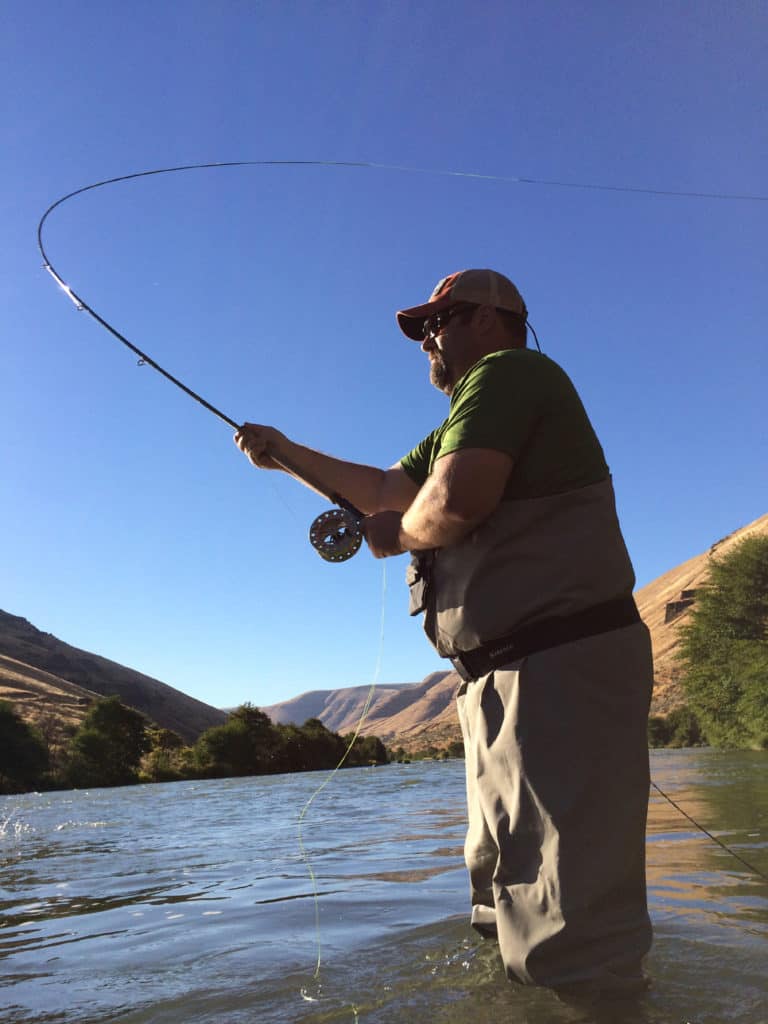
Fly fishing for steelhead is a bit more common to see with summer steelhead, but don’t discount winter fishing for these battlers.
A preferred technique used with steelhead fly fishing is with a Spey rod, as it has the length and backbone to handle these feisty fish.
Cast angles to cover as much of the run as possible, then step a few feet upriver and do it again.
Bring some colorful streamers and an assortment of other wet flies to bring them to the net. It is possible to have a non-stop action-filled day, but it is as common to get completely skunked.
Patience and proficient casting is bound to bring a steelie to net eventually. At worst, you may just have to try again soon. That doesn’t sound so bad, does it?
Where to Catch Steelhead
Ready to find your own steelhead? Try these resources on our website:

